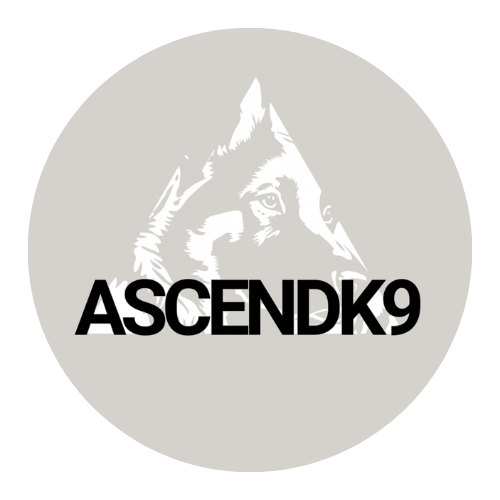Managing a Multi-Dog Household: Training, Boundaries & Real-Life Solutions
Bringing a second (or third) dog into your home can be a dream come true… OR a recipe for stress if things aren’t managed carefully.
At ASCENDK9, based in Harlow, Essex, we specialise in helping owners create calm, structured environments through reliable obedience and clear relationships. Whether you’re introducing a new puppy, managing dogs of different ages, or coping with the loss of a pet and supporting your remaining dog, this guide is for you.
We’ll walk you through the what, how, and why of managing multi-dog households, using proven dog training techniques like crate training, place training, and boundary setting. If you’ve ever asked, “How do I train both dogs without chaos?” - read on.
Training dogs together too soon can reinforce bad habits instead of building obedience.
Why You Need to Train Dogs Separately in Multi-Dog Households
It can be tempting to train your dogs together, especially if they seem bonded. But here’s the truth: Dogs learn best one-on-one.
Training dogs separately allows you to:
Work at their individual pace
Prevent distraction and competition
Strengthen your bond with each dog
Address behavioural issues before they escalate
Until your dogs have consistent obedience individually, group sessions are likely to reinforce bad habits or overstimulate both dogs.
Top Tip: In our puppy training in Hertfordshire and Essex, we always recommend building strong foundations separately before working on group skills.
Common Multi-Dog Household Questions
Q: Can older dogs bully younger ones?
A: Absolutely. Older dogs can become overly controlling, and puppies can become too pushy. Monitor both and interrupt overbearing or rude behaviour early.
Q: Should I separate dogs after a disagreement or fight?
A: Yes. Temporarily separating dogs gives everyone space to decompress. Reintroduce gradually with structure, training, and guidance from a professional dog behaviour specialist.
Q: Will my grieving dog be okay after the loss of their companion?
A: Dogs grieve too. Maintain structure, offer comfort, and consider gently reintroducing independence or training to give them focus and confidence.
Puppy energy can overwhelm older dogs - supervision is key.
Why Structure = Peace in the Home
Boundaries aren’t just about discipline… they create emotional safety.
In multi-dog homes, boundaries:
Prevent conflict over space or resources
Reduce the chance of jealousy or pushiness
Give dogs predictable rules that lower anxiety
Examples of healthy boundaries:
No rushing through doors
Waiting turns for meals or affection
Structured walk routines
Respect for personal space (especially on furniture)
Dogs don’t automatically know how to cohabit peacefully. It’s our job as owners to guide their interactions with intention.
Introducing a New Puppy into a Multi-Dog Household
Whether you're welcoming a young pup or adopting an adult, introductions must be intentional.
Here’s how to reduce tension from day one:
Neutral Territory First: Do initial greetings on a walk or in an open space before coming inside.
Use Parallel Movement: Walk dogs side by side at a comfortable distance to promote calm coexistence.
Crate and Rotate: Use crates and gates to give dogs downtime away from each other.
Supervise Closely: Don’t assume they'll “sort it out.” Intervene before tension builds.
Reward Calm Interactions: Mark and reward when dogs co-exist peacefully or ignore each other.
Need help? Our dog training in Essex includes tailored support for introducing a new puppy or rescue.
Boundaries reduce chaos - routines help dogs feel secure and cooperative.
How to Train Both Dogs… Without Losing Your Mind!
This is one of the top questions we hear from multi-dog owners:
"How do I train both dogs when they won’t stop interrupting each other?"
Here’s your plan:
Crate or place one dog while training the other. This teaches calm waiting and reduces interruptions.
Use high-value rewards to maintain focus.
Short sessions, repeated often are more effective than long, chaotic ones.
Rotate who goes first. Each dog should learn to work and wait.
Practice together only after individual skills are solid.
Consistency is everything. That’s why place training and crate training are foundational tools in our puppy training and dog behaviour work across Hertfordshire and Essex.
What To Do If There’s Been a Fight or Disagreement
Conflict can happen. What matters most is how you respond.
Step-by-step response:
Separate immediately and calmly. Avoid shouting or adding stress.
Give both dogs space to settle. Crate or separate rooms.
Reflect on what triggered the issue. Was it food? Space? Overexcitement?
Reintroduce only after calm is restored. Use leashes or baby gates for control.
Seek help from a qualified dog trainer. Ongoing tension needs professional support.
If you're in Harlow, Essex or surrounding areas, ASCENDK9 offers dog behaviour assessments and practical support to resolve multi-dog tension.
The Benefits of Crate Training and Place Training in Multi-Dog Homes
Want a calmer house? These two tools are essential.
Crate Training:
Provides individual rest zones
Helps dogs decompress
Prevents arguments when you're out
Place Training:
Teaches dogs to settle in one spot
Reduces chaos at doors or meal times
Builds impulse control in shared spaces
Dogs need to know how to switch off. That’s why these techniques are part of every ASCENDK9 dog training plan in multi-dog households.
Place training teaches dogs to switch off, even in a busy home.
5 Key Habits for a Harmonious Multi-Dog Home
Train one dog at a time daily.
Give dogs individual time with you.
Interrupt rude behaviour early.
Rotate toys, chews, and resting spots.
Stick to clear rules. Consistency matters more than perfection.
Need Help Managing a Multi-Dog Home?
If you're juggling multiple dogs and feeling overwhelmed, you don't have to figure it out alone. At ASCENDK9, we help dog owners across Essex and Hertfordshire achieve:
Peaceful introductions
Conflict-free coexistence
Strong, individual obedience
Real-life results using crate training, place training, and calm communication
Book a private lesson or virtual coaching session today and let’s build a better balance in your home.





